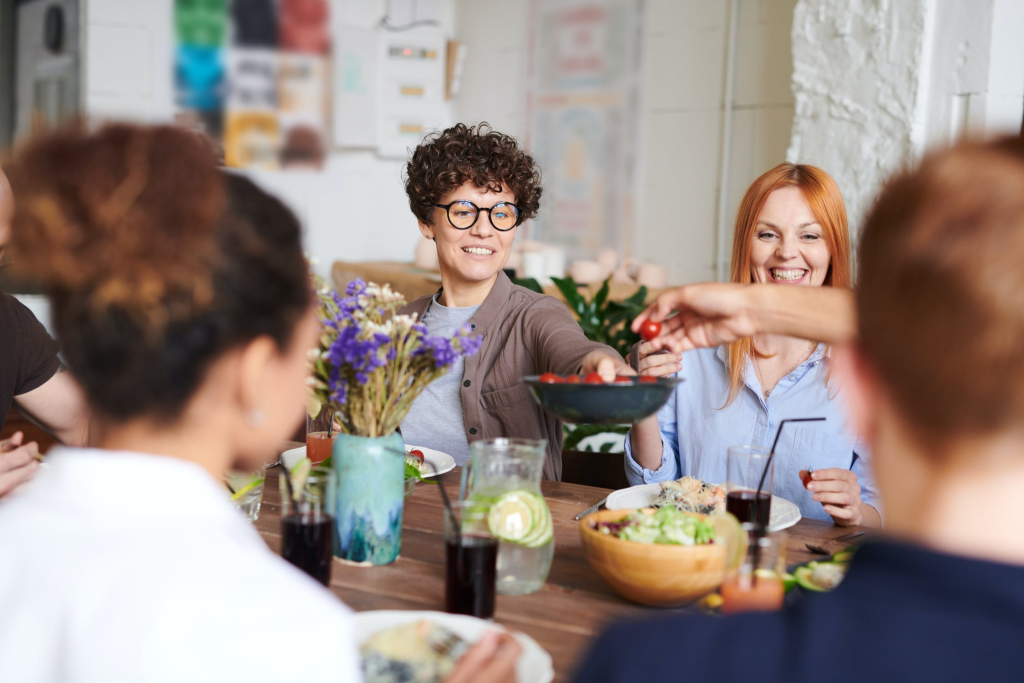The kitchen is a hub of human connection; it’s where culinary culture and delectable food meet heart-to-heart conversations and warm smiles.
The act of cooking and eating together has the marvelous potential to knead family dynamics into a cohesive whole. Even when functioning as your everyday laboratory for experimenting with recipes, the kitchen plays a significant role in family dynamics.
In this article, we will explore how cooking and eating together can help improve family dynamics.
Boosting Teamwork
When cooking and eating together, each participant contributes something to the table. It may be slicing the vegetables, kneading the dough, or merely setting out the cutlery.
Thanks to this shared responsibility, family members start appreciating teamwork; it’s like assembling a jigsaw puzzle where each piece matters. Consequently, accountability is taught without any need for preaching; actions become the best teacher here.
This harmonious blend of cooperation and responsibility fosters an improved family dynamic that leaves a sweeter aftertaste than any delightful dessert could ever have. The proof, indeed, is not just in the pudding but also in cooking it together!
Stirring Pots and Conversations
Another way how cooking and eating together can help improve family dynamics is by paving the way for improved communication within the family.
Cooking is like conducting a symphony of flavors; it needs precision, patience, and, most crucially, communication. Picture this drama unfolding in your family kitchen: while something simmers gently on the stove, you turn down the heat, imparting instructions softly yet clearly.
As these culinary procedures play out spontaneously, verbal exchanges bloom naturally. You’re not only stirring up delicious meals but also meaningful dialogues fostering open communication, essential for sprucing up family dynamics.
This lively interaction during meal preparation serves as a two-way street, allowing an ebb and flow of information as well as emotions. These candid conversations peeling away layers lead to stronger connections between family members.
Humor Sprinkled Over Shared Meals
Infusing humor into cooking and dining doesn’t just make for a fun experience; it also contributes positively to family dynamics.
Imagine this: grating cheese for a pizza, dad cracks a pun, “Great minds think alike,” which sets off a ripple of laughter around the kitchen. These candid, impromptu moments of humor lend charm and warmth to the act of cooking.
With a splash of laughter here, a pinch of smiles there, and the kitchen quickly transforms into a hub bubbling over with joy. The result? A light-hearted atmosphere is created, which is vital to conversations as seasoning is to the meal. Simply put, the shared jokes become like comfort food; they lighten stressful days at school or work and enhance overall family dynamics.
Cooking Together Promotes Learning and Development
There’s no denying that cooking together can have fruitful impacts on a child’s development. You see, the kitchen becomes an open classroom when we start cooking with our little ones.
The task of measuring ingredients morphs into a math lesson while demonstrating patience in slow-cooking dishes imparts the importance of timing. Even cultural education gets served hot! Giving your munchkins a background about the traditional tacos you’re preparing invites them into a vivid historical and geographical journey.
All these teachable moments occur organically without turning into tedious lectures, making learning fun and relatable for children. It’s as if they’re spoon-fed knowledge alongside those flavorsome delicacies. So with every meal cooked and shared together, we are subtly nurturing their intellectual growth, shaping family dynamics in an incredibly positive way.
Meal Times Foster Deeper Connections
Communal mealtimes hold precious potential in enhancing family dynamics. When families dine together, meals transform into time capsules, creating lasting bonds.
It’s like creating a shared memory album where every conversation, every laugh, and every tale spun around the dinner table adds a new page. These interactions set off chain reactions of empathy and understanding, breaking down walls of miscommunication that might have previously existed.
Besides nourishing their bodies, families sharing meals collectively nourish their relationships too. The dining area morphs into an arena for emotional exchange, smiles served with steaming soups, and forgiveness offered over buttery pastries.
As a result, every shared story around the dining table helps forge an emotional bridge, strengthening ties within the family, a deliciously simple yet effective remedy to better family dynamics.
Consider Getting Expert Help With a Difficult Family Dynamic
Sometimes, normal cooking or eating together may not help in improving family dynamics, especially if the bridges are too burned or the dishes are too complex. In these instances, delicately tossing in an expert view could be your much-needed secret ingredient. Family therapists or counselors not only offer advice but also present neutral perspectives, enabling healthier communication and interactions.
Adding this layer to the efforts of cooking and eating together could prove more fruitful than envisioned. The strategies learned from professionals can add depth to your culinary conversations and shared bonds: like that final dash of oregano giving identity to a pasta sauce. So remember, there’s no harm in reaching out for that extra pair of stirring hands when improving family dynamics!
Conclusion
The simple acts of cooking and eating together stitch the frayed threads of family dynamics into a vibrant tapestry that warms up every home. The kitchen and dining table become places where bonds are seasoned with united efforts, hearty laughter, learning moments, or even expert advice; places where connectivity is neither force nor feigned but flows as naturally as a river.
The beautiful symphony that resonates amidst peeled vegetables, simmering sauces, aromatic dishes, and shared meals evokes a sense of unity, a feeling fundamental to wholesome family dynamics.
Whether it’s amid bubbling pots or bowls filled with stories passed down generations, for families everywhere, these seemingly mundane routines could serve as the magic ingredient. They are the secret sauce to an enriching familial journey, proving that, indeed, the way to not just one’s heart but stronger family ties might be cheerfully cooking in the same pot.

